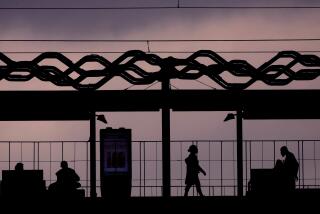A harbor in shallow trouble
Everyone agrees that thick sediment deposits are threatening to transform pristine Upper Newport Bay into a meadow.
But the biggest threat to the ecologically important estuary may not be the silt and mud clogging it. Instead, the culprit is likely another one: money. Or rather the lack of it.
A dredge and barge began work two years ago to remove 2.3 million cubic yards of built-up muck, with a projected cost of nearly $39 million. But with barely half the work done, local officials say a lack of funding could sink the project.
“We want to see the sediment removed to protect the resources of the ecological preserve from being damaged,” said Tom Rossmiller, Newport Beach harbor resources manager. “But also to keep the sediment from going into the Lower Newport Bay and creating a problem with boat navigation.”
The problem, officials and experts said, is that dredging the channel was deferred for a decade.
Since 1998, storms sent torrential runoff from upstream communities as far north as Lake Forest into San Diego Creek and filled the bay’s sediment catch basins.
That has resulted in tons of silt traveling from the ecologically sensitive upper bay into the city’s lower bay -- the marina area where thousands of boats are docked. At low tide, some are running aground in some silt-choked channels near Linda, Lido and Harbor isles.
“We have had grounding of vessels already, and at a recent regatta . . . alternative docks had to be set up in deeper water,” said Newport Beach City Councilwoman Leslie Daigle.
Last year, Daigle and the Newport Beach Chamber of Commerce sought a congressional allocation of $11 million to help with the dredging project but received only $2.2 million. In frustration, they began circulating a petition this month that urges the county’s congressional delegation to push for more money.
Upper Newport Bay is home to nearly 200 species of birds -- more than a dozen of them endangered. It is also an important stopover for birds on the Pacific Flyway and is the largest open-water estuary in Southern California.
The Army Corps of Engineers is the lead agency on the dredging project, which has removed about 800,000 cubic yards of sediment. But the corps is now in talks with the dredging company to possibly reduce the scope of the work in some areas, said Jane Grandon, a corps official with the Los Angeles office.
One of the two upper bay catch basins has been dug out, but removal of a small island that interferes with the basins and construction of a replacement island have not been completed, Grandon said.
“We want to get most of the dredging done as we can for the money we have, otherwise we will have to wait until more money comes,” she said.
Some officials estimate that it will cost an additional $1 million to restart the dredging if it comes to a halt.
About $13.5 million from the state and local sources has been spent. So far, $13.7 million of the roughly $25 million federal share has been provided, said city officials, who next want the corps to dredge the lower bay.
“We will be trying to get the Army Corps to continue the dredging, even if it is slowly, using some of their own funds so that we do not have to stop and then start, which would be very costly to everyone,” Rep. John Campbell (R-Irvine) said.
If finished as planned, the project would be the largest in the history of the bay. It would also mark the first use of a federal ecosystem restoration fund for the upper bay, which is a 752-acre paradise for environmentalists.
Many people hike, canoe, kayak and jog around the bay, watching egrets, skimmers, pelicans and other species, and studying native plants.
The bay was so choked with sediment and growth that coyotes and other predators were walking across mud flats to what had been small islands and disturbing nests and eating eggs, including those of the endangered least tern.
“With the dredging, we’re trying to build a deeper moat so coyotes won’t walk across,” said Terri Stewart, a state Fish and Game supervising biologist. The area, she said, “is critically important for endangered species,” including Belding’s savanna sparrow and light footed-clapper rail.
Not everyone is happy with the dredging, however. Some of the upper bay marinas and homeowners with boat slips expressed concern that dredging lowers the main channel, which means they then have to pay for dredging on their marinas.
Others have been critical of the site the corps chose to dump the sediment off the coast. A Laguna Beach conservation group argued that the corps did not notify the city that the Newport mud would be dumped off that city’s coastline. The corps notified Newport Beach but was not legally required to notify each coastal city, corps officials said.
The dump site became point of contention after the last dredging led to a $735,000 federal fine against Orange County and a contractor for ocean dumping violations. Those violations occurred during a massive two-year dredging operation in Upper Newport Bay when the sludge was taken to sea and dumped at least half a mile from the designated site.
Bob Caustin, director of Defend the Bay, defended the dredging operation, saying that critics “need to understand that dredging is not the problem. The lack of dredging is the problem.”
--
More to Read
Sign up for Essential California
The most important California stories and recommendations in your inbox every morning.
You may occasionally receive promotional content from the Los Angeles Times.










